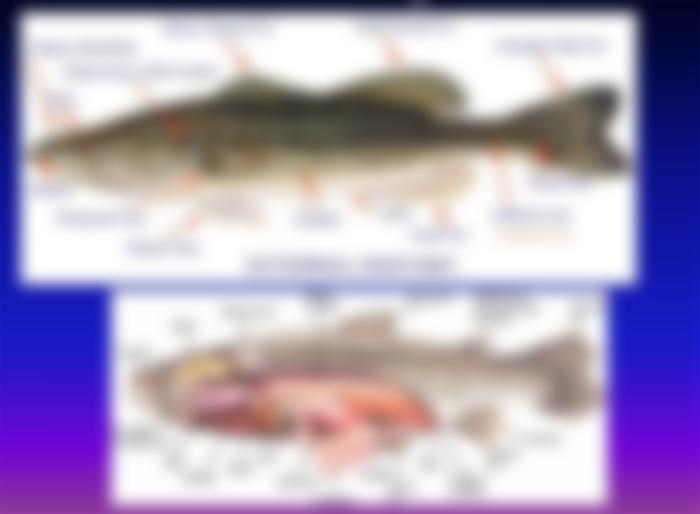
Today I will write only some basic things about fish.
The body structure of fish is adapted to life in the aquatic environment. Their body is elongated, spindle-shaped or laterally flattened. It consists of a head, trunk and tail that are firmly fused and connected to each other, in most species by a bony spine composed of vertebrae. From the vertebrae of the trunk are separated ribs that end freely in the body wall of the abdominal cavity. There are fins on the hull. The dorsal, caudal, and subfinal fins are odd, and the pectoral and ventral fins are even. The dorsal and subtails stabilize the body, the caudal fin together with the muscular tail participates in movement through the water, and the paired fins have the function of a rudder. The body of the fish is protected by a skin in which the shells are fixed, arranged like tiles on the roof. Carp have smooth, round shells, and perch rough, comb shells. Through the scales the skin secretes a thin epidermis full of mucous glands. Mucus protects the body from infections and reduces body friction when breaking through a thick water environment. Summer (wide) and winter (narrow) stripes are visible on the shell. By counting the narrow, winter, stripes, the number of winters in a fish's life can be determined. Beneath the skin are the muscles of the ring-shaped structure. On the back of the body, the muscle layer is much thicker than on the hips and abdomen.
The digestive organs begin with the oral cavity which is opened and closed by the jaws. Fish that have teeth on their jaws and other bones in the oral cavity hold their prey with their teeth. The teeth of predatory fish are sharp, worn out and replaced by new ones. Carp have toothless jaws, so they feed on tiny gill teeth located on the fifth, altered gill arch. The esophagus continues to the pharynx and passes into the stomach. From the stomach, chopped food enters the midgut. Stomachless fish have an enlarged first part of the anterior intestine. The hose ends with an outlet. The intestines of herbivorous fish are much longer than those of carnivores. Next to the intestine is the liver with the gallbladder and bile duct through which bile flows into the intestine. In bony fish, we find a swimming bladder in the body. In many fish, it is connected to the esophagus by a tube, while in other fish this connection has disappeared and the bladder has remained closed. The bladder acts as a hydrostatic device. Gas is secreted into it from the blood. By expelling the gas, the body shrinks, becomes heavier and the fish sinks. By filling the bladder with gas, the body increases in volume, becomes specifically lighter than water, and rises. The respiratory organs of fish, the gills, are located under the gill cover, on each side of the head, four, attached to the first four gill arches. Each gill consists of a double row of gill leaflets. By stretching the blood vessels in the gills, blood enters them and is brought by the blood vessels from the heart. The venous heart of the skeleton is two-part, consisting of the atrium and the ventricle. The blood is of variable heat, red in color from egg-shaped red blood cells. In bony fish, the midbrain and hindbrain are developed. Their forebrain is very small. The spinal cord extends to the brain and extends through the spinal cord. Its mass is significantly heavier than the brain. The eyes do not have eyelids, so the front of the eye is protected by a transparent cuticle. The accommodation of the eye, which adapts for near vision, is achieved by the fish by moving the round lens in the eyeball. Fish distinguish colors. This is best shown by trout in the selection of artificial flies when fishing. Fish hear through the labyrinthine organ that represents the inner ear. In its bags there are balance stones on which the age of the fish can be determined. Fish also smell by the senses located in the head, in the steamy nostrils. That is why in the preparation of food for collecting and catching carp today, various scents are added that attract fish and cause it to swallow the offered food. Along the lateral side of the body extends the lateral stripe, a tube passing under the punctured scales. There are sensory buds in the tube connected by nerves that bring stimuli to the brain. With the side stripe, the fish recognize the direction of movement, the strength of the currents, they feel the objects that stand in the direction of their movement. It also allows movement in muddy water.
Above the floating bladder, the kidneys extend in the form of dark red stripes. Blood flows through them leaving excreted substances from the body. Urine is performed by the ureters that open at the lump behind the stool.
At the time of spawning, the sexual organs stand out in particular. Their effluent steam tubes combine into an odd tube that carries sexual products into the water between the intestinal and urinary openings. The male gonads have the shape of whitish steam bands. At the time of spawning they are full of jelly. In the female sexual organs, the ovaries, eggs develop which we call eggs.
The male and female gonads are attached to the body wall and hang in the body cavity. Fish eggs are large cells visible to the naked eye. Carp eggs have a diameter of a millimeter, bream a millimeter and a half, catfish eggs are about three millimeters, and trout up to five millimeters. The living part of the egg is located at the top of the egg and is surrounded by a larger amount of nutrients, proteins and fats, part of which remains in the yolk sac after the larva emerges from the egg shell. Females lay a large amount of eggs. A female carp of 0.5 kg weighs up to 150,000, a female catfish lays up to 30,000 per kilogram of weight, a pike up to 40,000 per kilogram of weight, a young only about 1,000 pieces, and a trout up to 1,500 per kilogram of weight.
Our largest freshwater fish, the catfish, can reach a length of three meters. There are fish that live very long: a 35 kg pike is at least 80 years old, a 100 kg catfish is about 30 years old, while small fish live a short time.

I learned a lot about fish, I didn’t know big fish lived that long.